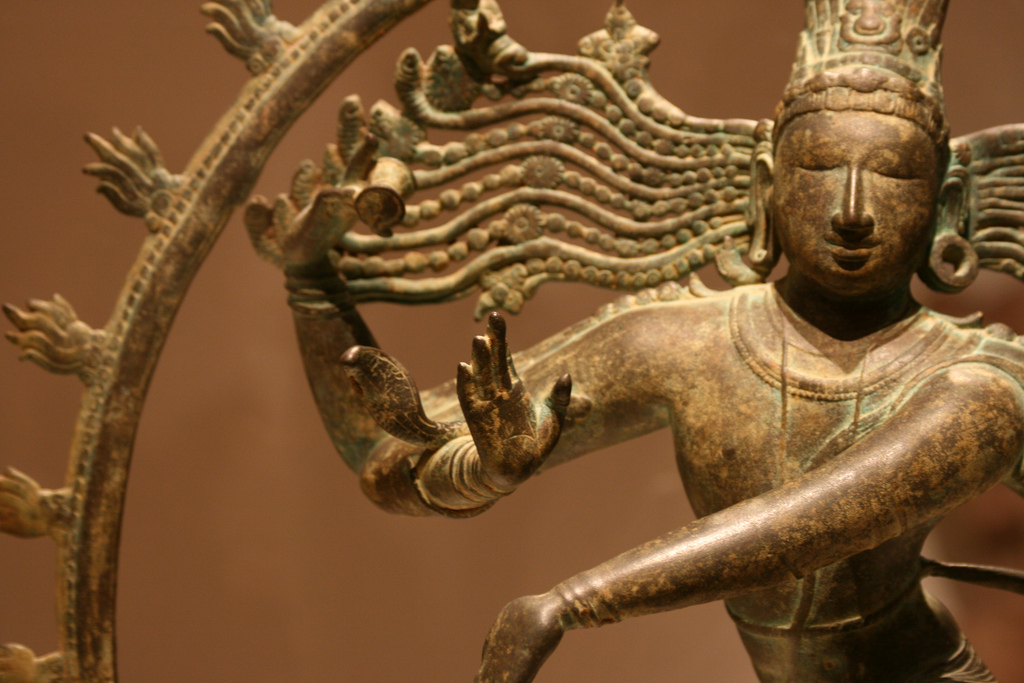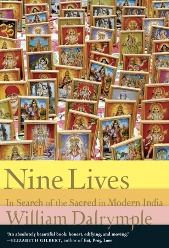
In Nine Lives: In Search of the Sacred in Modern India, William Dalrymple profiles the devotees of obscure and exacting religious traditions, who embody but also struggle with India’s high-speed modernization. He captures the mute sadness of a Jain nun who watches her closest friend ritually starve herself to death, the faithful mind of an illiterate goatherd who can recite from memory an ancient 200,000-verse epic poem, and the prison warden who, for two months of each year, is worshiped as a deity. Below, Dalrymple examines how every corner of southern India is imbued with divinity, and how its temples preserve the famed bronzes of an old dynasty, including the iconic dancing Shiva, above.
 There are few places in the world where landscape and divinity are more closely linked than in southern India.
There are few places in the world where landscape and divinity are more closely linked than in southern India.
In the sacred topography of the south, every village is believed to be host to a numberless pantheon of sprites and godlings, tree spirits and snake gods, who are said to guard and regulate the ebb and flow of daily life. They are worshiped and propitiated, as they know the till and soil of the local fields and the sweet water of the wells, even the needs and thirsts of the cattle and the goats of the village.
If the villages are the preserve of godlings and obscure village goddesses, then in the prosperous temple towns that dot the plains of the south many of the features of the landscape are animated with stories and myths which link them with the great pan-Indian gods Shiva, Vishnu and the Devi: on this shoreline, by this temple, the Devi does penance, waiting until the end of the great Cosmic Flood, after which she will finally celebrate her marriage; that rock was an evil elephant who attempted to trample the town’s Brahmins to death before being turned to stone by Lord Shiva; this temple marks the place where a peahen with beautiful eyes in its tail was revealed to be the goddess Parvati in disguise; the river there was created by Lord Murugan to quench the thirst of one of his wedding guests who had developed an unbearable craving for water after too much salty rice.
Lying in the centre of these towns, the great temples of Tamil Nadu are conceived as the palaces of the gods. But the gods of this country are understood to be jealous and territorial deities, and instead of sitting in their temple-palaces, their devotees believe that they like to oversee their domains. It is for this reason that on the great festivals they are taken out from the temples, robed, jeweled and garlanded, put on a palanquin or temple chariot, offered betel leaves and areca nuts, and then, like a raja surveying his dominions, given a tour so that they can establish their sovereignty, and be taken along a circuit of the borders of their kingdom.
Here in the streets and fields they receive tributes and offerings, while their devotees and subjects – including those of the lower castes who were traditionally not admitted to the temples – can see them, and make darshan, so giving the gods pleasure while at the same time providing spiritual merit for the devotees. Such expeditions sometimes end with the god taking a bath at the mouth of the delta of a sacred river, or taking a trip on a baot in a temple tank. On return the idols are bathed in milk, curds, butter, honey and sugar, and before being anointed with sandalwood paste and dressed in the finest silks.
When these temples were first built, the large stone idols of the temple sanctuaries were often found to be too large to move around. It was for this reason that in the tenth century the first portable bronze deities began to be cast in southern India. The art seems to have begun in the court of the Pallava monarchs of Kanchipuram, but it was under the patronage of their nemesis, the Chola kings of Tanjore, that the sculptors of this region brought the art to perfection. On the completion of their great dynastic temple in Tanjore in 1010 AD, the Cholas donated to their new structure no fewer than sixty bronze images of deities, of which about two-thirds were given by Rajaraja I, while the rest were given by his sisters, queens, officials and nobles. According to Srikanda, the Stpathy who oversaw all this casting was his direct ancestor, Kunjaramalla Rajaraja Perunthatchna.
Exquisitely poised and supple, these Chola bronze deities are some of the greatest works of art ever created in India. They stand quite silent on their plinths, yet with their hands they speak gently to their devotees through the noiseless lingua franca of the mudras – gestures – of south Indian dance. For their devotees, their hands are raised in blessing and reassurance, promising boons and protection, and above all, marriage, fertility and fecundity, in return for the veneration that is so clearly their divine right.
It is the Nataraja, Shiva as Lord of the Dance, which is arguably the greatest artistic creation of the entire Chola dynasty. On one level Shiva dances in triumph at his defeat of the demons of ignorance and darkness, and for the pleasure of his consort. At another level – dreadlocks flying, haloed in fire – he is also dancing the world into extinction so as to bring it back into existence in order that it can be created and preserved anew. With one hand he is shown holding fire, signifying destruction, while with the other he bangs the damaru drum, whose sound denotes creation. Renewed and purified, the Nataraja is dancing the universe from perdition to regeneration in a circular symbol of the circular nature of time itself.
In Western art, few sculptors – other than perhaps Donatello or Rodin – have achieved the pure essence of sensuality so spectacularly evoked by the Chola sculptors, or achieved such a sense of celebration of the divine beauty of the human body. There is a startling clarity and purity about the way the near-naked bodies of the gods and the saints are displayed, yet by the simplest of devices the sculptors highlight their spirit and powers, joys and pleasures, and their enjoyment of each other’s beauty.
In one idol in the Tanjore Museum, Lord Shiva reaches out and fondly touches the breast of his consort, Uma-Parvati, who is naked but for anklets, bangles and waistband supporting a thin and diaphanous silk wrap. In another he nuzzles the back of her naked shoulders or touches the lobe of her ear. It is a characteristically restrained Chola way of hinting at the unmatched erotic powers of a god whose iconic image is the phallic symbol, and who is celebrated in the scriptures for his millennia-long bouts of Himalayan love-making. In some Tamil temples, the last act of the priests, before they close the doors of the inner shrine is to remove the nose jewel of the bronze idol of Shiva’s consort lest the rubbing of it irritate her husband when they make love – an act, so the priests will tell you, that ensures the preservation and regeneration of the universe.
Excerpted by permission of Alfred A. Knopf, Inc., a division of Random House, Inc.
*Photo above courtesy quinn.anya. Homepage photo courtesy ‘Fatemah’.




Send A Letter To the Editors